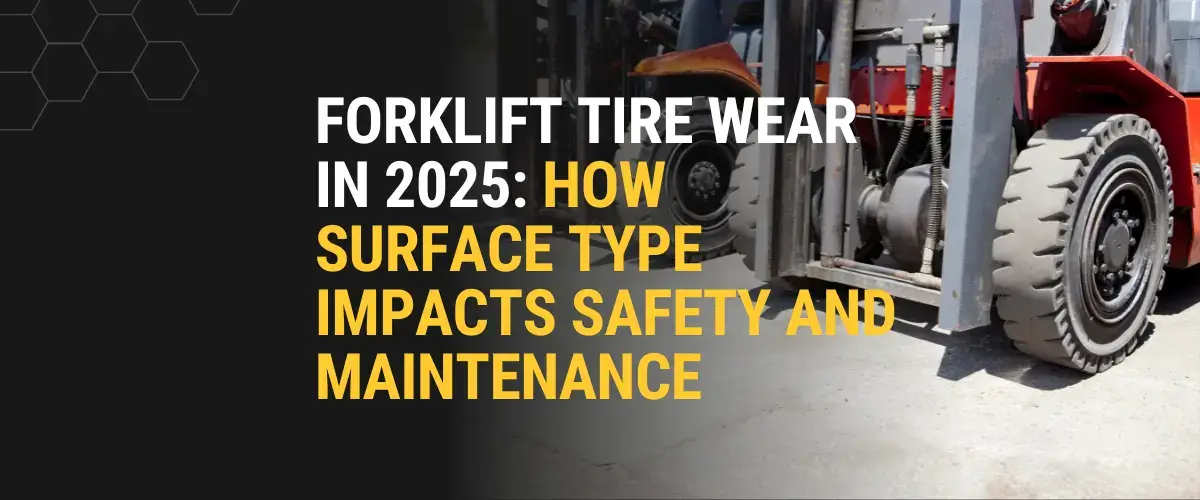
Forklift Tire Wear in 2025: How Surface Type Impacts Safety and Maintenance
Quick Facts About Forklift Tire Wear in 2025
- Tires wear faster on rough or uneven surfaces like gravel or asphalt.
- Cushion tires are best on smooth indoor floors like concrete.
- Pneumatic tires handle outdoor terrain but wear differently depending on the surface.
- OSHA requires daily inspections of tires for wear, cuts, or unsafe tread.
- Tire choice impacts safety, stability, and long-term maintenance costs.
Why Forklift Tire Wear Matters
Forklift tires aren’t just rubber on wheels. They affect stability, braking, and how safe the machine is to operate.
When tires wear down too quickly, you’re not only spending more on replacements-you’re putting operators at risk. OSHA requires that worn or damaged tires be taken out of service immediately. That’s why understanding how different surfaces affect tire life is critical.
Surface-by-Surface: How Forklift Tires Hold Up
Concrete Floors
Best option: Cushion tires
Wear factors: Low rolling resistance means cushion tires last longer indoors, but rough concrete or debris can shorten life.
Safety note: Cracked or uneven concrete increases vibration, which accelerates wear and reduces operator comfort.
Asphalt or Gravel
Best option: Pneumatic tires
Wear factors: Gravel and rough asphalt grind down treads faster. Punctures are common without proper inflation.
Safety note: Daily checks for cuts, embedded debris, or low pressure are essential to prevent blowouts.
Dirt or Muddy Yards
Best option: Pneumatic tires with deep tread
Wear factors: Soft, uneven ground causes faster tread loss and can bog down forklifts if tires aren’t suited.
Safety note: Keep loads low and watch traction. Tires with shallow tread can spin out or destabilize the forklift.
Mixed Surfaces (Indoor to Outdoor)
Best option: Solid pneumatic or hybrid tires
Wear factors: Constantly shifting between smooth concrete and rough outdoor terrain shortens tire life quickly.
Safety note: Train operators to adjust speed and load handling when transitioning between surfaces.
OSHA Requirements and Forklift Tire Safety
OSHA requires operators to check tires before each shift. That means looking for:
- Excessive wear or bald spots
- Cuts, gouges, or chunks missing
- Underinflated or flat pneumatic tires
- Tires too small for the load being carried
If a tire fails inspection, the forklift must be taken out of service until repaired or replaced. Skipping this step can result in fines or worse-accidents.
How Thompson Lift Truck Helps Reduce Forklift Tire Wear
- Recommending the right tires for your surface type
- Offering maintenance programs to catch problems early
- Providing OSHA-compliant inspection checklists
- Stocking quality cushion, pneumatic, and hybrid tires across the Southeast
When you match the right forklift tires to your work environment, you extend tire life, reduce downtime, and stay OSHA-compliant.
Conclusion
Surface type plays a big role in how long your forklift tires last-and how safe your team is on the job.
Choosing the wrong tire can mean faster wear, more maintenance costs, and increased accident risks. The right tire, paired with regular inspections, keeps operations moving smoothly.
FAQs About Forklift Tire Wear
What causes forklift tires to wear out quickly?
Rough surfaces, heavy loads, and improper tire choice (using cushion tires outside, for example) cause rapid wear.
Which forklift tires are best for concrete floors?
Cushion tires are ideal for smooth indoor surfaces like concrete.
Do forklift tires need daily inspections?
Yes. OSHA requires operators to inspect tires at the start of each shift.
What’s the difference between cushion and pneumatic forklift tires?
Cushion tires are for smooth indoor surfaces; pneumatic tires handle outdoor and rough terrain.
How can I extend forklift tire life?
Choose the right tire for your surface, maintain proper inflation, and train operators to drive safely.

